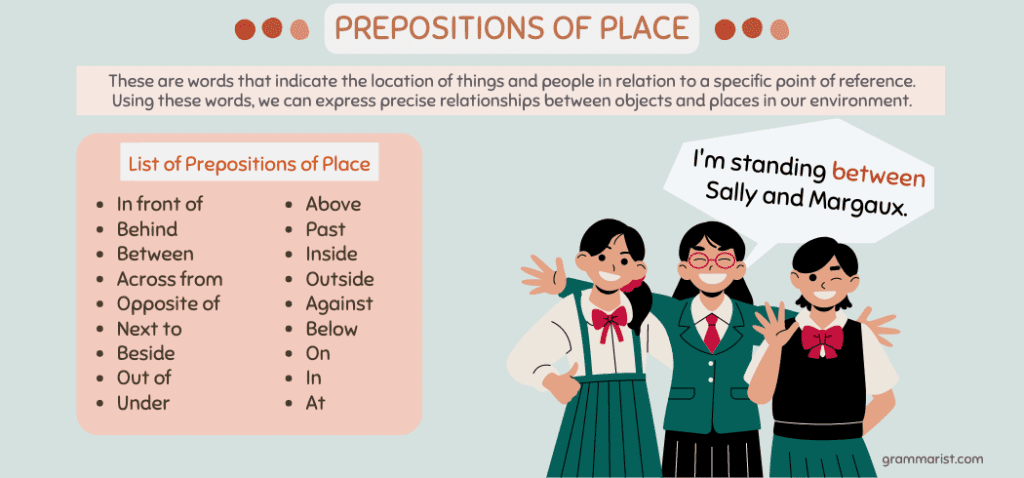Prepositions of place not only help us to communicate more precisely but also provide us with valuable information about our surroundings. Whether we realize it or not, prepositions allow us to make over 100 distinct distinctions about the world around us. I use them every day in speech and writing. Read on as I break down the fundamentals of the question ‘what is a preposition of place’ and help you expand your English vocabulary!
What Are Prepositions of Place?

Prepositions of place are a fundamental part of the English language. These highly versatile words enable us to express relationships between people, objects, and places in various contexts. They indicate the location of someone or something, either standalone or in a relationship to a reference point.
These are words that indicate the location of things and people in relation to a specific point of reference. Some common prepositions of place are “on,” “above,” “below,” “in,” and “between.” Using these words, we can express precise relationships between objects and places in our environment.
For example, the preposition “at” is typically used when discussing a specific location, like a city or street address. Similarly, the preposition “in” is often used when referring to an enclosed space, such as a room or building. Other common prepositions of place include “on,” “above,” and “below.”
Why We Use the Prepositions of Place
Prepositions help to clarify the location or placement of different entities within a sentence. They also provide information on the direction or orientation of various objects.
For example, the preposition “by” indicates that an object is located closely beside another object, while the preposition “through” tells us the direction of something moving within its environment. Other common prepositions of place include “on,” “in,” and “at.”
As a fiction writer, these words are extremely important to my descriptive writing. They help me create a visual for the reader to show them what’s happening in a scene, where characters and objects are, etc. Here’s an excerpt from one of my books with prepositions of place underlined to show you what I mean.
“I stared at the moon as it shone down on us from above, bathing us in silvery moonlight. The grass beneath my bare legs brushed my skin with a cool tickle and I reached for my best friend’s hand in the space between us.”
Many of these prepositions are used quite frequently in our everyday language, helping us to describe spatial relationships with clarity and precision. Furthermore, they allow us to navigate complex environments by providing clues about location and orientation, making them an essential part of language use.
List of Prepositions of Place
There are plenty of prepositions of place that one can use to express the placement of someone or something. Here is a preposition of place list to help you out:
- In front of
- Behind
- Between
- Across from
- Opposite of
- Next to
- Beside
- Out of
- Under
- Above
- Past
- Inside
- Outside
- Against
- Below
- On
- In
- At
Prepositions of Place in Sentences

Let’s take a look at some prepositions of place sentences:
- I put the ring back inside your jewelry box.
- He met Sarah at the corner cafe.
- I wanted to place these photos above the fireplace.
- Tim, the cat’s on the table again!
- They opened up a new restaurant across from the bookstore.
- I’m growing eggplants in my garden.
Practice with Prepositions
Prepositions of place help to articulate where events or objects exist in relation to the speaker or hearer. Some prepositions of place are simple and almost universal, such as “on,” “in,” and “at.” But there are also more complex prepositions that require a deeper knowledge of context and grammar rules. Thus, learning prepositions of place is an important step toward achieving mastery of a new language.